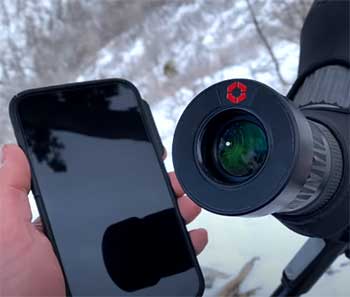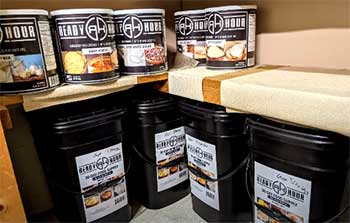So you want to try digiscoping – the art of taking photos through a spotting scope with your camera – but aren’t sure which adapter to get. Two of the most popular options are the Ollin and Magview digiscoping adapters.
But what’s the difference between them and which is better for your needs?
In this comprehensive comparison, we’ll look at the key features and pros and cons of the Ollin and Magview digiscoping adapters to help you decide which is right for your setup and style of digiscoping.
A Brief Comparison Table
| Feature | Ollin | Magview |
| Design | Enclosed hood | Open frame |
| Weatherproofing | Fully sealed | Minimal |
| Camera Attachment | Threaded, tight fit | Clamp, slightly off-axis |
| Tripod Mount | Built-in | Requires separate tripod plate |
| Ambient Light Control | Excellent | Can be prone to glare |
| Compatibility | Limited eyepiece sizes | Works with most scopes |
| Weight | Heavy, bulky | Extremely light |
| Price | $200+ | $80-100 |
Key Differences Between the Ollin and Magview
The Ollin and Magview digiscoping adapters take two different approaches:
- Ollin: Fully-enclosed adapter that attaches over the scope eyepiece like a lens hood
- Magview: Open frame adapter that clamps around the eyepiece
This core design difference leads to some notable pros and cons between the two options:
Ollin

- Fully weatherproofed, protects scope eyepiece
- More secure camera attachment
- Heavier and bulkier
- No ambient light leakage
- Compatible with fewer spotting scopes
Magview
- Open design is lighter and more compact
- Quicker to attach and detach camera
- Ambient light can lead to glare issues
- Works with a wider range of spotting scopes
- Less impact on optical quality of scope image
Now let’s explore these key differences in more detail…
Ollin Digiscoping Adapter
The Ollin digiscoping adapter takes a enclosed hood approach to connecting your camera securely over the spotting scope’s eyepiece.
Here are the main features and benefits of the Ollin adapter:
- Fully Weatherproofed Design
The Ollin completely encloses the scope eyepiece like a lens hood to protect it from the elements. This makes it a good choice for using your scope in rain, snow, and other wet conditions where moisture could otherwise seep into the eyepiece.
- Secure Camera Attachment
With the Ollin’s enclosed design, your camera rests right up against the adapter so there is no slack or wiggle room when attached. This helps keep your camera securely in place and optimized for sharp photos through the scope.
- Dedicated Lens Ports for Telephoto Lenses
The Ollin adapter has threaded ports designed specifically for attaching telephoto lenses from Nikon, Canon, and other major brands. This optimized alignment helps you get the best quality images without vignetting.
- Built-In Tripod Mount
The adapter has a tripod mount built right into its base. This allows you to easily connect it to a tripod or monopod for added stability and to help manage the weight of your scope and camera gear.
- No Light Leakage
Because it fully encloses the eyepiece, the Ollin design prevents ambient light from seeping in and causing glare or washout in your images. This helps you achieve better image quality.
Downsides of the Ollin
The Ollin isn’t without its downsides, however:
- It is quite large and heavy compared to other adapters. This adds more bulk to your gear.
- The enclosure limits compatibility to specific scope eyepiece sizes. It may not fit some spotting scopes.
- Some users report the adapter can impact the optical quality from the scope, possibly reducing sharpness.
- It’s one of the more expensive digiscoping adapters.
Overall though, the Ollin is arguably the most robust and high quality digiscoping adapter option out there in terms of build construction and features tailored to digiscopers.
Magview Digiscoping Adapter
Now let’s look at the Magview digiscoping adapter. This is a less enclosed, open frame design.
Here are the main features and pros of the Magview:

- Lightweight and Compact Design
Weighing just over 2 ounces, the Magview is extremely lightweight and much smaller than many competitors.
This makes it ideal if you want to travel light and keep things portable.
- Quick Camera Attachment and Removal
The open design allows you to easily slide your camera on and off the adapter.
This makes it faster to attach your camera on the fly when a bird or wildlife pops into view.
Also Read: Differences Between Sirui ST-124 And ST-125 Tripods.
- Compatible With More Spotting Scopes
Because it doesn’t enclose the eyepiece, the Magview can accommodate a wider range of spotting scope sizes and brands. It also works with telescopes and monoculars.
- Minimal Impact on Image Quality
The open frame doesn’t degrade the optics of the scope, providing brighter, sharper images in some cases.
- More Affordable Price Point
The Magview retails for around $80-100 in most cases, making it one of the more budget-friendly digiscoping options out there.
Downsides of the Magview
Here are a few of the potential downsides to consider with the Magview:
- Less weatherproofing and eyepiece protection than enclosed models.
- Ambient light can leak in and cause glare or reflections.
- The camera sits slightly off the eyepiece, which may allow more motion and shake.
- Not compatible with lenses that require a threaded attachment.
- No built-in tripod mount.
So in summary, the Magview trades off some image quality, stability, and robustness for simplicity of use, affordability, and compatibility with the open frame design.
Digiscoping Use Cases and Recommendations
Now that we’ve compared the key features and tradeoffs of the Ollin and Magview adapters, which is generally better for certain digiscoping scenarios?
Here are some recommendations on which adapter may be a better fit based on your needs:
- For birding digiscopers:
The Magview tends to be a good fit for birders and wildlife photographers who prioritize rapid camera mounting, lighter weight in the field, and flexibility with different spotting scopes. The quick attachment system allows you to snap photos the moment a bird comes into view.
- For digiscoping in wet or cold conditions:
The Ollin is the better choice if you plan to use your spotting scope in wet weather or low temperatures. The enclosed hood design protects the eyepiece and prevents moisture or frost from forming on the lens.
- For planetary and lunar astrophotography:
Astrophotographers digiscoping planetary objects like the moon favor the Ollin since ambient light control is critical. The full enclosure prevents light pollution and creates optimal contrast.
- For those on a tight budget:
If you’re looking for the most affordable way to start experimenting with digiscoping, the Magview delivers good quality for the price. The Ollin is a more significant investment upfront.
- For digiscopers looking to add a telephoto lens:
The threading on the Ollin makes it easy to directly mount a telephoto DSLR lens over the eyepiece. This isn’t possible with the open design of the Magview.
- For maximum stability and sharpest photos:
The Ollin’s tighter camera coupling and built-in tripod mount generally provide the most shake-free stability. This can give slightly better sharpness if pixels are highly cropped.
Also Read: Is Magview Better Than Phone Skope?
Digiscoping Tips for Beginners
New to digiscoping? Here are some tips to help you get the best results when starting out:
- Use a sturdy tripod to minimize camera shake that can reduce image sharpness. A monopod or window mount also helps stabilize your setup.
- Spotting scopes with ED glass deliver sharper, higher contrast images ideal for digiscoping.
- Set your camera to aperture priority mode so you can dictate depth of field while the camera selects the shutter speed.
- Stop down the aperture to f/8-f/11 to get more of your subject in focus when digiscoping birds or wildlife.
- Use fast shutter speeds to avoid motion blur when handholding your gear. 1/1000 is a good target.
- Enable your camera’s live view so you can review and magnify the scoped image to ensure accurate manual focus.
- Shoot in RAW format to have more flexibility in bringing out details in post-processing.
- Use your camera’s self-timer or remote shutter release to prevent vibrations when triggering exposures.
Final Thoughts
In the battle of Ollin and Magview digiscoping adapters, there’s no definitive winner. The best option depends on your specific needs and where you plan to use digiscoping in the field.
The Ollin provides the most robust and high quality solution for wet weather use, astrophotography, and optimizing stability. But it comes at a higher price and weight.
The Magview is more portable, flexible, and budget-friendly. Though better suited to fair weather digiscoping and scenarios where rapidly attaching your camera is key.
Hopefully this detailed comparison gives you a better sense of which adapter aligns with your goals and style of digiscoping photography.
Both the Ollin and Magview provide a great starting point for unlocking the photographic potential in your spotting scope and taking your field photography to new magnifications!


